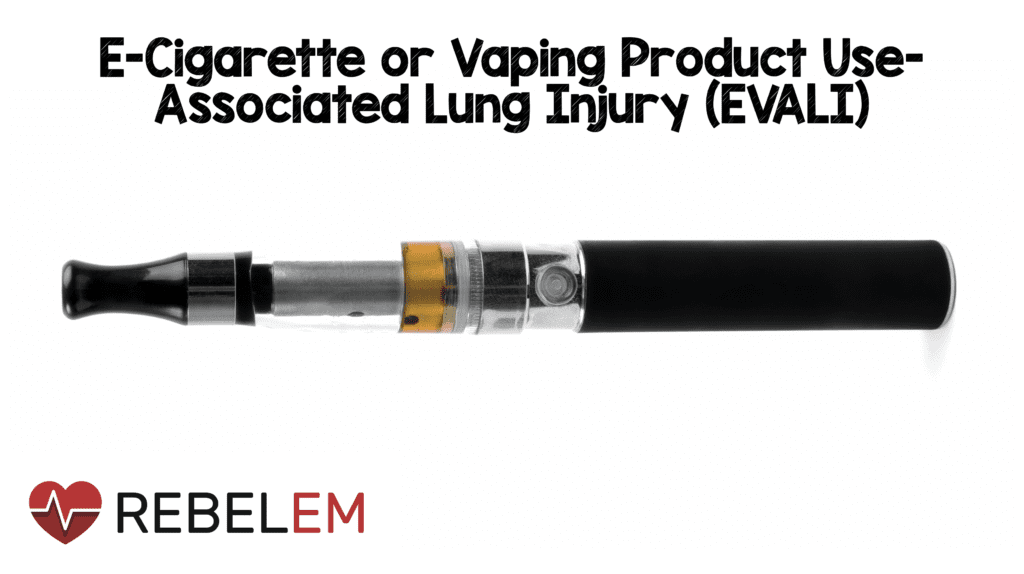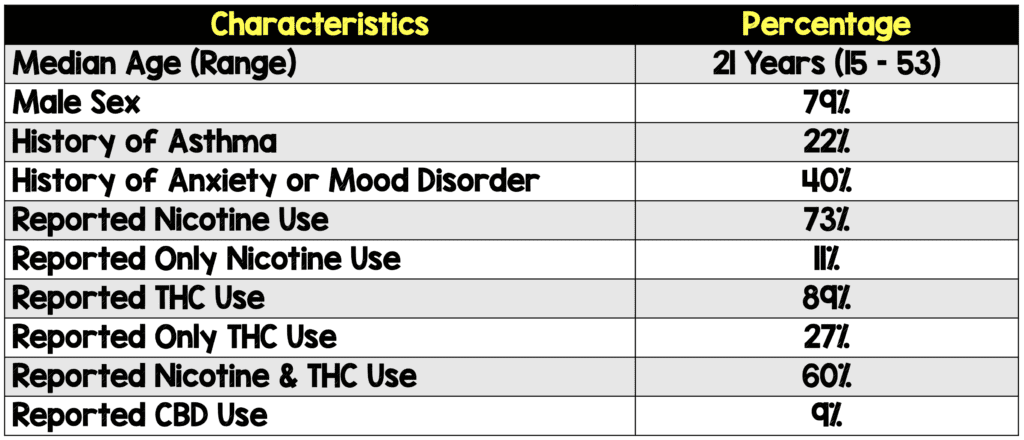

Article: Layden JE et al. Pulmonary Illness Related to E-Cigarette Use in Illinois and Wisconsin – Final Report. NEJM 2020. PMID: 31491072
What They Did:
- Collected information (chart review and standardized interview) and performed descriptive analysis on patient demographics, signs and symptoms, and management of EVALI in a case series of reports to the Wisconsin Department of Health Services (WDHS) and the Illinois Department of Public Health (IDPH) of patients recent e-cigarette use with pulmonary infiltrates in whom alternate etiologies had been ruled out
- Conducted syndromic surveillance of emergency department visits for severe unexplained respiratory symptoms
Inclusion:
- Case Series:
- Cases (n=98) reported to the WDHS and the IDPH of respiratory illness with use of an e-cigarette or dabbing in the 90 days preceding symptom onset
- Pulmonary infiltrate on imaging and absence of other primary etiologies for respiratory symptoms (e.g., suspected secondary pneumonia meeting the other criteria would be included as a probable case)
- Syndromic Evaluation:
- 14 to 30 years of age
- ED visit between January 1, 2018 through August 15, 2019 in affected counties in Illinois
- Presenting with severe respiratory symptoms with initial pulse oximetry of 96% or less (or not recorded) who were admitted or not discharged home and with no known etiology upon admission
Exclusion Criteria:
- Evidence of alternative primary diagnoses for respiratory symptoms
Results:
- In the syndrome surveillance portion of the study, there were twice as many patients presenting for severe respiratory illness in the time frame studied when compared to the previous year.
- In the case-series portion of the paper, 142 cases were reported. 30 were excluded during the chart review phase. 14 were excluded due to incomplete information.
- 98 cases meeting established criteria were used for this case series
- Wisconsin = 41 cases
- Illinois = 57 cases
- Standardized interviews were completed for 83% of the patients.


These two tables are useful for physicians in identifying the clinical picture of patients presenting with EVALI: The patients tend to be younger males presenting with shortness of breath (85%), cough (85%), and subjective fever (84%). Interestingly, a large percentage also experienced abdominal pain (34%) and/or diarrhea (44%). From the interviews, only 11% of patients reported only vaping nicotine-containing products (as opposed to CBD or THC-containing products). 89% reported vaping THC-containing products. The most common brand reported from those who used THC-containing products was “Dank Vape” (67% of those interviewed who reported THC use), which raises the possibility of harmful additives in this product.
- 83% of patients had an abnormal chest x-ray, and all who received a CT scan had bilateral infiltrates on chest CT. The imaging findings were not consistent with lipoid pneumonia as previously reported. The majority of patients were treated with glucocorticoids and antibiotics.
- Of the 44 patients who received antibiotics:
- Azithromycin = 20
- Amoxicillin-clavulanate = 6
- Levofloxacin = 5
- Doxycycline = 4
- All patients’ respiratory symptoms progressed and required hospital admission
- Of the 44 patients who received antibiotics:
- Clinical Course:
- 93/98 patients required hospitalization
- Median duration of hospital stay = 6 days
- ICU admission for respiratory failure = 53% of patients
- Intubation = 26%
- Met Berlin criteria for ARDS = 12/25 (48% with average PaO2/FiO2 = 189mmHg
- No tracheostomies required
- 2 patients required ECMO
- 1 death
Strengths:
- Thorough details provided about presenting symptoms, laboratory results, imaging results, and treatment using chart reviews and patient interviews
- First case series to describe a large cluster of temporally related pulmonary illnesses linked to the use of e-cigarettes
- A case definition of EVALI was developed and refined in coordination with the CDC
- Medical charts were reviewed with at least two reviewers per chart and discrepancies between reviewers were adjudicated by means of consensus
- IDPH performed near real-time pre-diagnosis surveillance by searching data sources from regional EDs that could provide early detection of a potential public health threat using the National Syndromic Surveillance Program
Limitations:
- The paper is a case series, which inherently limits the conclusions that can be drawn
- Unfortunately, the bronchoalveolar lavage samples were not sent for mass spectrometry to determine if vitamin E acetate was present
- There is the potential for misclassification: patients may be reluctant to admit to using THC due to its legal status, so cases of recent vaping and/or vaping of THC may be underreported (recall bias)
- 43 patients received antibiotics and glucocorticoids prior to bronchoalveloar lavage which may alter the results of the samples
- This case series may represent more severe cases and may not give information on more mild clinical presentations as they typically do not come to the hospital
- Many patients did not have exhaustive negative findings on serologic tests for infectious causes, cultures, or molecular studies which means several patients may have been labelled EVALI, when in fact they had a different diagnosis
Discussion:
- EVALI Case Definitions:
- Laboratory analysis conducted by the Food and Drug Administration identified vitamin E acetate in THC-containing e-cigarette products and testing by the CDC on clinical bronchoalveolar lavage samples have consistently identified this as well while vitamin E acetate is not identified in control samples. It therefore may be that vitamin E acetate is associated with this lung injuries.
- Important note: eosinophilia not widely see in peripheral blood nor in bronchoalveolar lavage specimens. Also, exogenous lipoid pneumonia (i.e., low-attenuation consolidations) were not reported as characteristic of radiographic findings.
Authors’ Conclusions:
“Case patients presented with similar clinical characteristics. Although the definitive substance or substances contributing to injury have not been determined, this initial cluster of illnesses represents an emerging clinical syndrome or syndromes. Additional work is needed to characterize the pathophysiology and to identify the definitive causes.”
Clinical Take-Home Points:
The clinical presentation of EVALI based on this case series typically occurs in young males with subjective fever, dyspnea, cough, abdominal pain, and diarrhea which overlaps with many respiratory illnesses (including the recent COVID outbreak) and remains a diagnosis of exclusion. Inquiring about vaping is important, and the specific products should be recorded.
References:
- Layden JE et al. Pulmonary Illness Related to E-Cigarette Use in Illinois and Wisconsin – Final Report. NEJM 2020. PMID: 31491072
- Blount BC et al. Vitamin E Acetate in Bronchoalveolar -Lavage Fluid Associated with EVALI. NEJM 2020. PMID: 31860793
- CDC. Outbreak of Lung Injury Associated with E-Cigarette use, or Vaping. CDC Website (Accessed April 9th, 2020) [Link is HERE]
Post Peer Reviewed By: Salim R. Rezaie, MD (Twitter: @srrezaie)
The post E-Cigarette or Vaping Product Use-Associated Lung Injury (EVALI) appeared first on REBEL EM - Emergency Medicine Blog.
